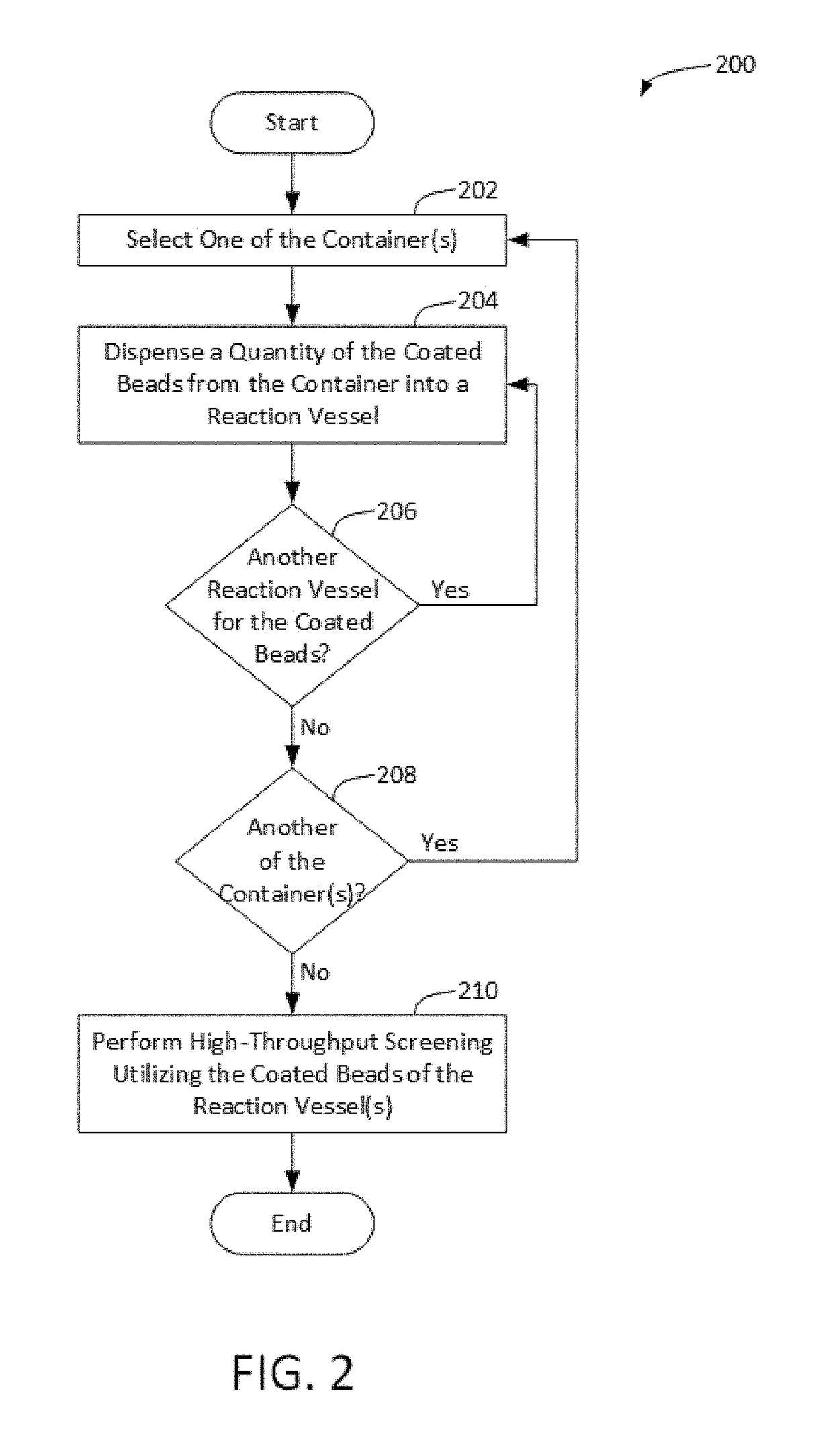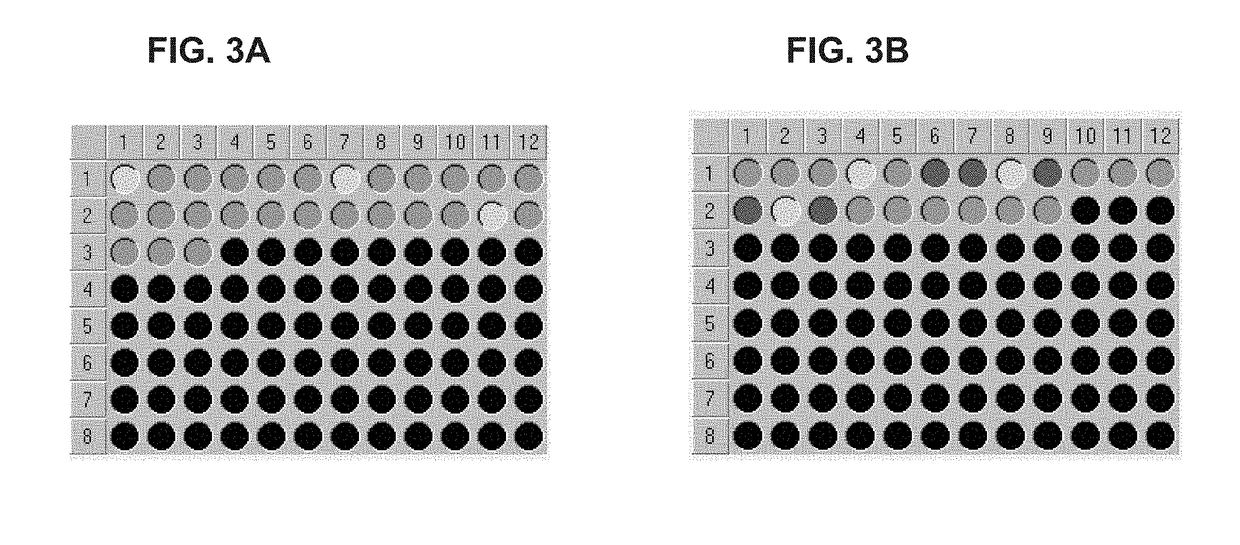High Throughput Methods for Screening Chemical Reactions Using Reagent-Coated Bulking Agents
- Summary
- Abstract
- Description
- Claims
- Application Information
AI Technical Summary
Benefits of technology
Problems solved by technology
Method used
Image
Examples
example 1
Accuracy & Reproducibility of Coated Beads
[0169]Glass beads (Sigma-Aldrich) and ketoprofen were combined in a mixing vessel. The vessel was capped and placed in an acoustic mixer and mixed for 15 min at 60% intensity (Resodyn Acoustic Mixer) to provide 2% (w / w) reagent-coated beads as described herein.
[0170]Glass beads (Sigma-Aldrich) and 1-[Bis(dimethylamino)methylene]-1H-1,2,3-triazolo[4,5-b]pyridinium 3-oxid hexafluorophosphate (HATU) were combined in a mixing vessel. The vessel was capped and placed in an acoustic mixer and mixed for 15 min at 60% intensity (Resodyn Acoustic Mixer) to provide 3% (w / w) reagent-coated beads as described herein.
[0171]A solid dispensing unit (SWAVE; Chemspeed® Technologies) was used to dispense 5 mg to 50 mg of coated beads to 4 mL vials. The amount of chemical in each vial was quantified using qNMR (with internal standard). Data are presented in Table 3 and Table 4.
TABLE 3Ketoprophen-coated beads.TargetActualDeviationWeight ofCompoundCompoundfrom%B...
example 2
Stability of Reagent-Coated Beads
[0173]Glass beads (Sigma-Aldrich) and Pd(dppf)C12 were combined in a mixing vessel. The vessel was capped and placed in an acoustic mixer and mixed for 15 min at 60% intensity (Resodyn Acoustic Mixer) to provide 2% (w / w) reagent-coated beads as described herein.
[0174]Consistency and integrity of the coated beads was assessed initially and after storage for about 6, 12, and 18 months at ambient conditions. Data are presented in Table 5.
TABLE 5Stability of Pd(dppf)Cl2-coated beads.InitialAssessment atAssessment atAssessment atPropertyAssessment~6 mo~12 mo~18 moFlowabilityFlowableFlowableFlowableFlowableColorLight brownLight brownLight brownLight brownUnboundedNot observedNot observedNot observedNot observedmaterialPurity (NMR)PurePurePurePureError (qNMR)4% at 0.65 mg6% at 1.4 mg6% at 0.7 mg5% at 0.7 mg
example 3
Solid Reagent Dispensing for Micro-Scale Test Library
[0175]In the following examples, starting material or core was reacted with a variety of monomers to elucidate monomer(s) to be advanced to a production run. Non-reactive or low purity monomers lead to poor production runs, which wastes core, time and general resources on failed reactions. A micro-scale (e.g., 0.5 mg-1 mg) test library and / or automated dispensing of sub-milligram scale reagents provides for more efficient production runs.
3.1. Synthesis of a 5-substituted 2-hydroxybenzoic Acid
[0176]Twenty-seven micro-scale reactions were performed as follows: 1 mg starting material (5-bromo-2-hydroxybenzoic acid) was mixed with a boronic acid or pinacol boronic ester monomer (1.5 eq), Cs2CO3-coated glass beads, and Pd(dppf)Cl2-coated glass beads. Glass beads were dispensed to provide 0.3 mg Pd(dppf)Cl2 per reaction and 4.5 mg of Cs2CO3 per reaction. The general reaction scheme is shown in Scheme 3.1:
[0177]Results from the micro-sca...
PUM
 Login to View More
Login to View More Abstract
Description
Claims
Application Information
 Login to View More
Login to View More - R&D
- Intellectual Property
- Life Sciences
- Materials
- Tech Scout
- Unparalleled Data Quality
- Higher Quality Content
- 60% Fewer Hallucinations
Browse by: Latest US Patents, China's latest patents, Technical Efficacy Thesaurus, Application Domain, Technology Topic, Popular Technical Reports.
© 2025 PatSnap. All rights reserved.Legal|Privacy policy|Modern Slavery Act Transparency Statement|Sitemap|About US| Contact US: help@patsnap.com



